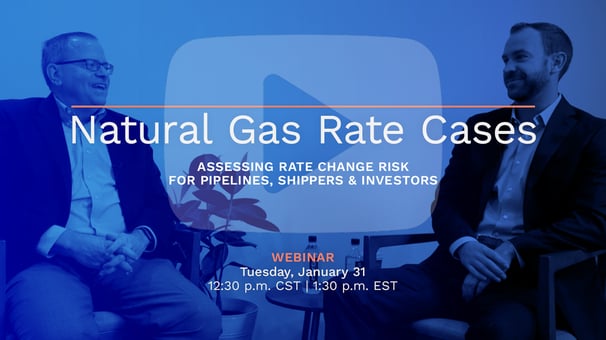As we discussed in FERC Launches Two Gas Pipeline Rate Cases – Are More on the Way?, FERC launched two rate investigations before the end of last year, and data shows more are likely on the horizon, since 40 more pipelines earned a 2021 return at or above the ROE we calculated for those pipes.
Rate cases — while a normal and essential part of the FERC regulatory process — can be a complex topic, but it’s essential for various gas industry participants to understand, anticipate, and track them. That’s why we’re joining with East Daley on Today, January 31 at 12:30 P.M. CST, for a comprehensive webinar on rate cases, risk assessment, and implications for pipelines, shippers, and investors.

Click here to register for the webinar.
Pipelines must understand rate cases and related risk to anticipate filings by competitors, benchmark strategies, study proceeding testimony and adequately monitor results. It’s critical also for natural gas shippers using long-term contracts to evaluate rate risk potential for current and future contracted capacity; this understanding provides a stronger negotiating position, and often tips the balance when comparing competing transport options. And for investors in the publicly traded companies that own these pipelines, an understanding of each subsidiary’s rate risk impacts the financial outlook at the broader entity level. If a public company’s pipelines are ripe for a rate increase, that may help improve returns, but conversely if its pipelines are overearning, the revenue of the public company could be at risk.
We’ll begin with a basic overview — the purpose and types of rate cases, how and when they are likely to be initiated, common terminology and calculations, process, timing, and potential outcomes. Next, we will apply this foundation to a discussion of recent cases and industry-wide trends we’ve observed in the past few years. And finally, recent activity within Kinder Morgan’s portfolio of pipes provides an illustration of rate risk and impact at the entity level from an investor perspective.
We hope you’ll tune in (and forward to a colleague or friend) to refresh and sharpen your rate case knowledge, and to learn about the related datasets and analyses available to you as a valued customer of Arbo.
Email us to share a particular question or aspect of rate cases you’d like to be sure we address.